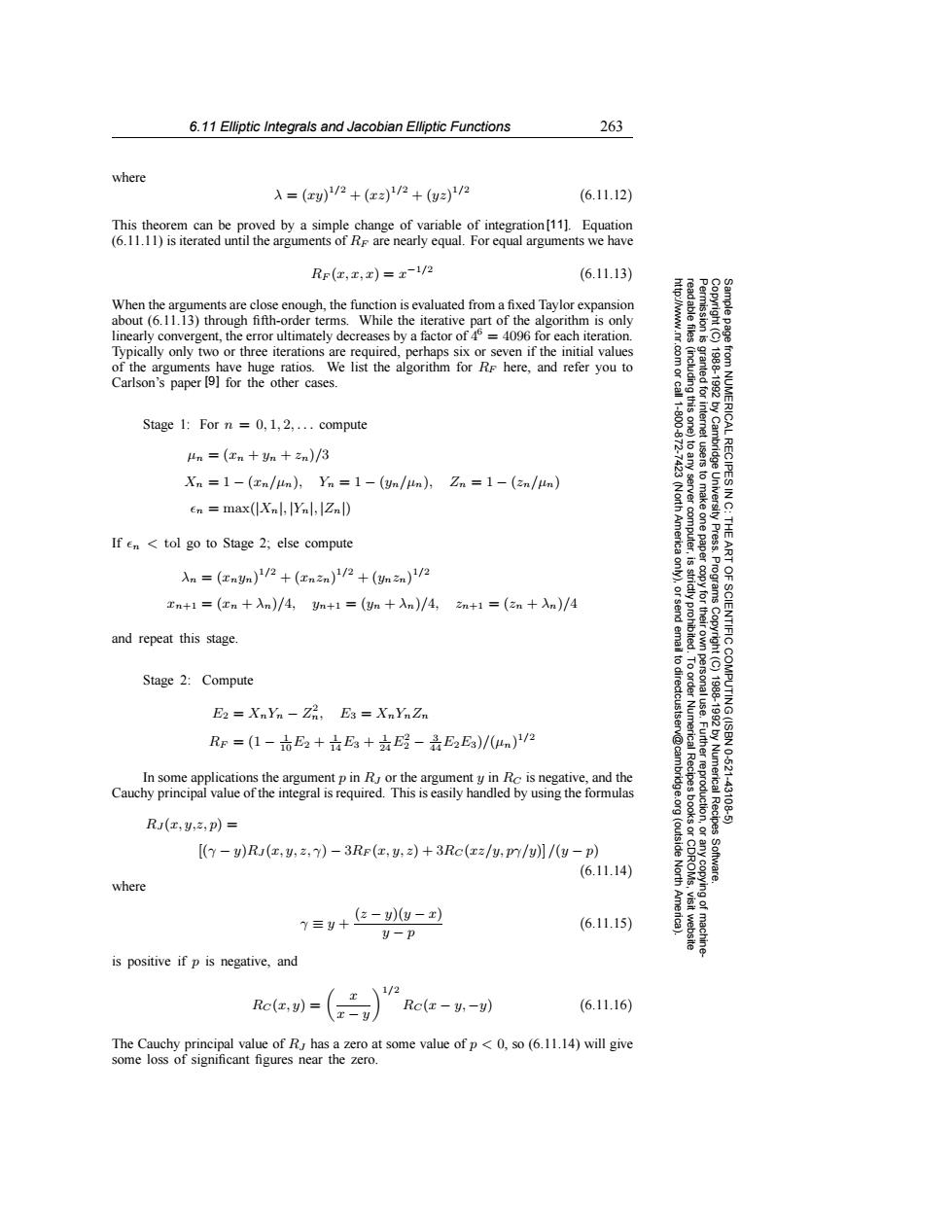正在加载图片...

6.11 Elliptic Integrals and Jacobian Elliptic Functions 263 where 入=(x)/2+(ez/P+(g2)2n (6.11.12) This theorem can be proved by a simple change of variable of integration[11].Equation (6.11.11)is iterated until the arguments of Rr are nearly equal.For equal arguments we have RF(e,x,x)=x-1/2 (6.11.13) When the arguments are close enough,the function is evaluated from a fixed Taylor expansion about(6.11.13)through fifth-order terms.While the iterative part of the algorithm is only linearly convergent,the error ultimately decreases by a factor of 4=4096 for each iteration. Typically only two or three iterations are required,perhaps six or seven if the initial values 81 of the arguments have huge ratios.We list the algorithm for Rr here,and refer you to Carlson's paper [9]for the other cases. a Stage 1:For n 0,1,2,...compute 4n=(xn十yn+zn)/3 Xn =1-(En/un),Yn=1-(yn/un),Zn=1-(zn/un) RECIPES En max(Xn,Yn,2n) (North 令 If en<tol go to Stage 2;else compute America computer, make one paper University Press. THE ART n=(EnUn)112+(Enzn)112+(Unzn)1/2 Programs xn+1=(xn+入n)/4,yn+1=(ym+入n)/4,zm+1=(zn+入n)/4 ictly proh and repeat this stage to dir Stage 2:Compute E2 XnYn-Zn;Es XnYnZn 1881992 OF SCIENTIFIC COMPUTING(ISBN RF=(1-六E2+六E+六E-是E2E3)/(un)2 In some applications the argument p in Ry or the argument y in Rc is negative,and the Numerical 10-521 Cauchy principal value of the integral is required.This is easily handled by using the formulas Recipes 43108 RJ(x,y之,p)= [(Y-y)RJ(E,y,2,7)-3RF(,y,z)+3Rc(Ez/y,PY/y)]/(y-p) (outside (6.11.14) Software. where Y三y+2-g-) (6.11.15) y-P is positive if p is negative,and 1/2 Rc(z,y)= Rc(-y,-y) (6.11.16) T-y The Cauchy principal value of Ry has a zero at some value of p<0,so (6.11.14)will give some loss of significant figures near the zero.6.11 Elliptic Integrals and Jacobian Elliptic Functions 263 Permission is granted for internet users to make one paper copy for their own personal use. Further reproduction, or any copyin Copyright (C) 1988-1992 by Cambridge University Press. Programs Copyright (C) 1988-1992 by Numerical Recipes Software. Sample page from NUMERICAL RECIPES IN C: THE ART OF SCIENTIFIC COMPUTING (ISBN 0-521-43108-5) g of machinereadable files (including this one) to any server computer, is strictly prohibited. To order Numerical Recipes books or CDROMs, visit website http://www.nr.com or call 1-800-872-7423 (North America only), or send email to directcustserv@cambridge.org (outside North America). where λ = (xy) 1/2 + (xz) 1/2 + (yz) 1/2 (6.11.12) This theorem can be proved by a simple change of variable of integration [11]. Equation (6.11.11) is iterated until the arguments of RF are nearly equal. For equal arguments we have RF (x, x, x) = x−1/2 (6.11.13) When the arguments are close enough, the function is evaluated from a fixed Taylor expansion about (6.11.13) through fifth-order terms. While the iterative part of the algorithm is only linearly convergent, the error ultimately decreases by a factor of 46 = 4096 for each iteration. Typically only two or three iterations are required, perhaps six or seven if the initial values of the arguments have huge ratios. We list the algorithm for RF here, and refer you to Carlson’s paper [9] for the other cases. Stage 1: For n = 0, 1, 2,... compute µn = (xn + yn + zn)/3 Xn = 1 − (xn/µn), Yn = 1 − (yn/µn), Zn = 1 − (zn/µn) n = max(|Xn|, |Yn|, |Zn|) If n < tol go to Stage 2; else compute λn = (xnyn) 1/2 + (xnzn) 1/2 + (ynzn) 1/2 xn+1 = (xn + λn)/4, yn+1 = (yn + λn)/4, zn+1 = (zn + λn)/4 and repeat this stage. Stage 2: Compute E2 = XnYn − Z2 n, E3 = XnYnZn RF = (1 − 1 10E2 + 1 14E3 + 1 24E2 2 − 3 44E2E3)/(µn) 1/2 In some applications the argument p in RJ or the argument y in RC is negative, and the Cauchy principal value of the integral is required. This is easily handled by using the formulas RJ (x, y,z, p) = [(γ − y)RJ(x, y, z, γ) − 3RF (x, y, z)+3RC (xz/y, pγ/y)] /(y − p) (6.11.14) where γ ≡ y + (z − y)(y − x) y − p (6.11.15) is positive if p is negative, and RC (x, y) = x x − y 1/2 RC(x − y,−y) (6.11.16) The Cauchy principal value of RJ has a zero at some value of p < 0, so (6.11.14) will give some loss of significant figures near the zero.�